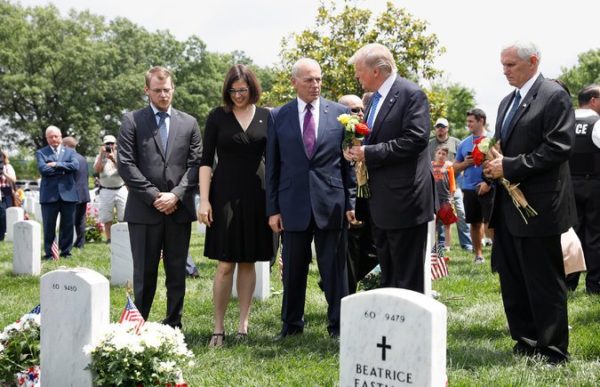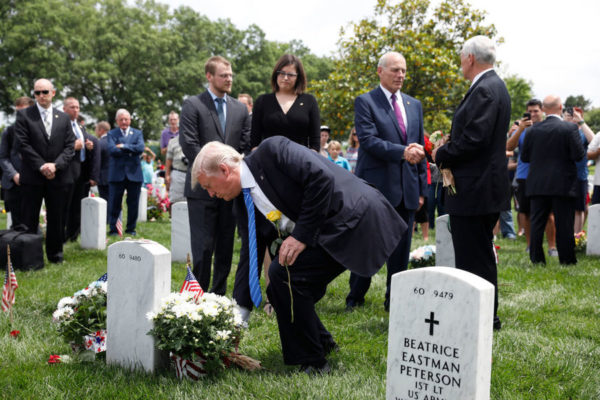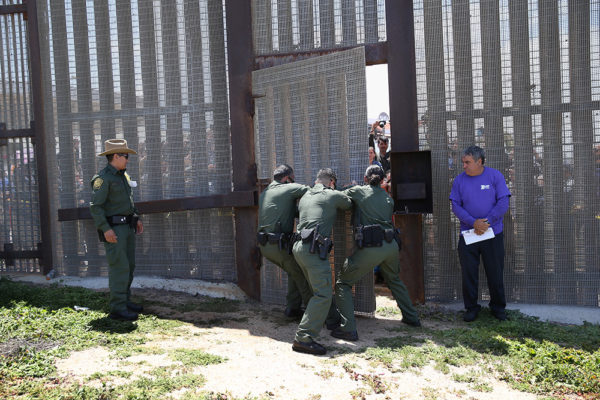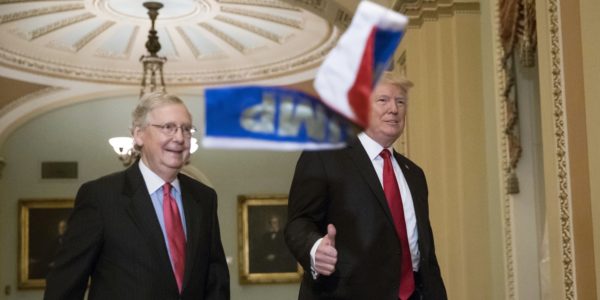Notes
Looking at Trump and Kelly at Arlington Cemetery

Honoring deceased military personnel at Arlington National Cemetery is at once among the most solemn duties undertaken by an American president and the quintessential photo-op for the commander-in-chief. Since its establishment as the nation’s military cemetery during the Civil War, news media have visually recorded presidents’ attendance at annual memorial commemorations. These pictures typically feature the head of state bowed in silence in front of a row of gravestones.
Last Thursday, the New York Times republished a photograph from Memorial Day of President Trump with John Kelly, then Director of Homeland Security, two of Kelly’s children, and Vice President Pence. They appear at the gravesite of Kelly’s son, Second Lieutenant Robert Kelly, who died in Afghanistan in 2010. The photograph accompanies a news story about a speech by now Chief of Staff Kelly, in response to a swirling controversy over Trump’s condolence call to Myeshia Johnson, the widow of Sgt. La David T. Johnson who died in an ambush of four American soldiers in Niger the previous week.
Photo-ops at Arlington Cemetery typically provide occasions for Presidents to appear above the fray of political divisions and controversies. The Times’ choice puts a particular spin on Kelly’s speech as the photograph only partially complies with genre conventions for presidential visits to Arlington. As one might expect, headstones in the foreground draw the viewer into the scene where Trump stands next to Kelly and his children, with Pence slightly distant from the other dignitaries. The flowers in Trump and Pence’s hands signal commemoration while the small flags by the graves both in front and behind the five figures mark this place as a military cemetery.
In other ways, though, the photograph doesn’t quite capture the solemn mood expected of this type of photo-op. Kelly’s daughter appears to be smiling, while inexplicably Pence seems left out of the group. Behind them, visitors in shorts and bright orange, red and blue-colored clothing stand out against the somber apparel of the official mourners. Bright sunshine washes out the sky and the tops of the heads of the foreground figures, adding a summer-like tourist atmosphere to the mourning ritual.
I’m curious as to why the New York Times selected this picture amongst all those taken that day. Another photograph from the Memorial Day service, also by Aaron Bernstein, more readily conforms to expressions of honor and respect.

Here, Trump appears in the process of placing flowers on the grave as Kelly’s daughter gazes in his direction with a somber expression. Meanwhile, her father shakes the Vice President’s hand. Although tourists can still be seen in the background, they are less prominent behind the Secret Service personnel and others standing in observance.
Instead, the off-kilter photograph appears in the article about Kelly’s stunning denunciation of those who apparently disrespected the military by publicizing the president’s remarks. In his speech, Kelly charged that Florida Rep. Frederica Wilson took Trump’s remarks to Johnson out of context and politicized them for her own gain. Given Kelly’s reproof of the President’s critics, the visual optic of Trump and Kelly in conversation in the Times’ photo takes on a faintly ominous tone.
The Times decision to reproduce this 5-month old photograph also ensures that Trump remains at the center of this controversy. In response to a plethora of tweets and comments, Wilson and members of Johnson’s family denounced Trump’s failure to use La David Johnson’s name and his assertion that the soldier knew what he was “getting into.” To them, and to many of us, Trump’s seemingly trivializing language and lack of recognition of this African American soldier’s identity has racist connotations, given the nation’s history of racial violence, oppression, and exclusion.
Beyond Kelly’s rebuke of such criticism, the Chief of Staff marshals all his authority in this speech to bemoan the loss of American values. “Women were sacred, looked upon with great honor. That’s obviously not the case anymore as we see from recent cases,“ Kelly decried. He goes on to lament, “Life, the dignity of life, is sacred. That’s gone. Religion, that seems to be gone as well. Gold Star families, I think that left in the convention over the summer.”
Kelly’s invocation of sacred icons revitalizes a prominent strain in American political iconography that has historically aligned racial ideals of white womanhood, domesticity, and Christian values with that of the nation. This outmoded ideal is strikingly tone deaf in relation to the visual scene of memorialization, for the tombstone closest to us in the near row – more fully distinguishable in the second photo – is that of a woman soldier.
Gender and racial ideals that historically constrained all women’s positions in society have also justified the exclusion of African Americans and other marginalized people from the imagined city on the hill. Significantly, no people of color appear in the Times photograph. For some, this absence may call attention to the differences in the president’s response to the former General’s loss and his condolence call to Johnson. At the least, the lack of people of color in the picture strikes an odd note given the racial diversity in the military today.
There is no doubt the crafting of news is a highly selective process. Acknowledging that, I still welcome the choice to unsettle Trump and Kelly’s picture of national citizenship, based as it is on outdated racial ideals of gender, family, and religion.
– By Wendy Kozol
Photo: Aaron P. Bernstein/Getty Images. Caption: Mr. Trump with Mr. Kelly, then the secretary of homeland security, in May at the grave of Mr. Kelly’s son Second Lt. Robert Kelly at Arlington National Cemetery. Photo 2: Aaron P. Bernstein/Getty Images. Caption: As Vice President Mike Pence and Secretary of Homeland Security John Kelly shake hands, President Donald Trump lays flowers on the grave of Kelly’s son Robert at Arlington National Cemetery on May 29, 2017 in Arlington, Virginia. Marine Lieutenant Robert Kelly was killed in 2010 while leading a patrol in Afghanistan.


Reactions
Comments Powered by Disqus